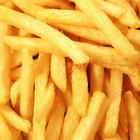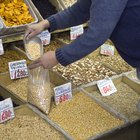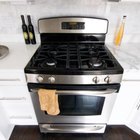FotoCuisinette/iStock/GettyImages
Melting plastic, leached chemicals and bodily burns are three risks of cooking at high temperatures in plastic bags. The FDA regulates the safety of plastic containers so that they can be used for boiling or heating foods. This also includes the cooking method called sous vide, which cooks food in water in a sealed plastic bag but below boiling temperatures.
Harvard Medical School recommends heating foods only in approved containers that are labeled as such, especially when heating in the microwave. When you sous vide, use food-grade vacuum sealing bags and only used them with a vacuum-sealing system.
Dangers of Melting
Some bags are made from plastic that is too thin to boil without melting. They recommend calling the manufacturers of the plastic bag and asking them what the softening point is.
For example, Ziploc brand bags have a softening point of 195 degrees, which means they would melt at boiling point, 212 degrees. This will ruin both the food and the dishes the bags are in.
Possibility of Chemical Leaching
When plastic is boiled, the chemicals used to produce it can leach into the food being prepared due to a high temperature. Polycarbonate plastic releases the chemical Bisphenol A (BPA), but there are other types of plastic bags, including high-density polyethylene, low-density polyethylene and polypropylene, that don't leach this chemical.
Cheap plastic bags that are sold in bulk aren't safe for cooking food in, but even with the safer bags, However, there's still a risk that these types of plastic will release non-BPA chemicals, but the specific amount and risks are unknown. To determine which type of bag is which, check that they're labeled "microwave-safe."
Risk of Burns
When water is boiled in a bag, bubbles can form, which could burst when the bag is moved. Even if the water is outside the bag, the bag itself can still burst open when temperatures get very high. If either of these two things happen, the cooks may get burns on their face or hands.
Adding salt or other spices can produce the same effect because it disturbs the bubbles that have formed, causing them to erupt. Additionally, a bag can ignite, producing a fire and subsequent burns to a person standing nearby. This is most common when using a microwave oven.
Related Articles

Is It Safe to Cook Vegetables in ...

Heating Foods in Plastic & BPA

The Safety of Refrigerators and ...

What Is Oil Blanching?

What Are the Dangers of Plastic Bags ...

How to Boil Ziploc Bags

How Do Cooking Bags Shorten Cooking ...

Bagel Bites Heating Instructions

What Are the Best Containers to Freeze ...

The Ingredients in Bag Balm

Calories in a Bag of Chocolate Chips

How to Cook a Roast in a Bag

Disadvantages of Using Plastic Bags

Why Does Food Cook Faster in a Pressure ...

Are the Nutrients Lost in Slow Cooking?

Purpose of Moth Balls

What Are the Dangers of Tantalum?

Uses of Macadamia Nut Shells
How Long Can Food Stored in Canning ...

The Best Types of Pans to Cook ...
References
- Harvard Medical School: Microwaving Food In Plastic: Dangerous or Not?
- North Dakota State University Agriculture Communication: Prarie Fare: Unusual Containers for Preparing Foods Not Always Safe
- Bon Appetit: Is It Safe to Cook With Plastic Bags? And Other Sous Vide Questions, Explained
- Modernist Cuisine: Is It Safe to Cook with Plastic?
Writer Bio
Eliza Martinez has written for print and online publications. She covers a variety of topics, including parenting, nutrition, mental health, gardening, food and crafts. Martinez holds a master's degree in psychology.